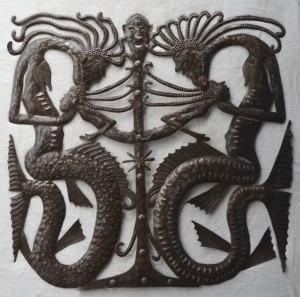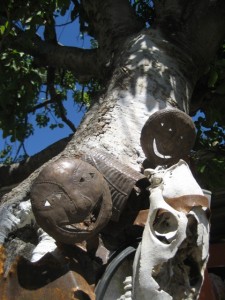The Enduring Mystique of La Sirene
Mermaids are the among most ubiquitous of sea creatures, at least from a cultural point of view. They appear in ancient legends of the deep from Egypt and Greece, the Eskimos have them in their lore, as do the Western Europeans, Australian Aborigines and the tribes of Africa. Across boundaries of time and space, this half woman, half fish is at once powerful, beautiful, protective, hypnotic, and dangerous.
It was from the combined influences of West African spirit worship and Western European folklore that mermaids made their entrance into the New World. Mami Wata, as the sea spirit was known to West African tribes, was an integral part of the belief system that traveled with enslaved Africans to the Americas. Reestablished and revisualized across the Atlantic, Mami Wata emerged in new communities and under different guises, among them Yemanja, Santa Marta la Dominadora, and most commonly, La Sirene. African–based faiths honoring these manifestations of Mami Wata continue to flourish today throughout the Americas, including Brazil, the Dominican Republic, and Haiti.
From Europe, and beginning with Christopher Colombus, mermaid veneration and ideology was reinforced. During his explorations of Hispaniola Colombus wrote of seeing, “…three mermaids, though these were not as pretty as mermaids that had been previously described to me. In fact, somehow in the face, they appeared more as men.” Too bad for Colombus. Years later in 1614, Captain John Smith had a more pleasant experience, taking note of a lovely mermaid that had, “a fish-tail, round eyes, a finely-shaped nose, well-formed ears, and long green hair.” Though he could not have failed to notice her naked breasts, his impression of that was delicately omitted from the Captain’s log…(!)
In the practice of Voodoo today, La Sirene is recognized as a strong female deity. She is capable of bestowing great fortune and even magical powers upon those who do her honor, and bringing catastrophy to those with whom she is displeased. Her beauty strenghens her powers of enchantment but also causes her to be vain. She is associated with lunar movements and also with dreams which she uses as tools of inspiration and creativity for endeavors such as writing, painting, and music. In reference to these characteristics, La Sirene is often depicted with a mirror, a comb, and a horn or other musical instrument. Of these items, the mirror is most significant. The glass itself is representative of the sea, while the back of the mirror is the dividing point between La Sirene’s underwater world and ours.
Contributed by Linda for It’s Cactus



![sm355[1]](https://blog.itscactus.com/wp-content/uploads/2012/12/sm35511-218x300.jpg)


![2691[1]](https://blog.itscactus.com/wp-content/uploads/2012/12/269112.jpg)
